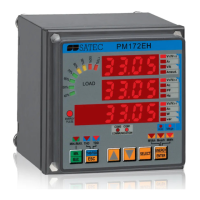Appendix B Using Setpoints
73
Using Time Triggers
If you want the setpoint actions to be synchronized with the clock, for
example, to provide synchronous recording interval data every 15 minutes
or each hour, or to output time pulses through relay contacts, use the time
triggers that generate static events synchronized to the device clock.
You can exercise the default setting for Setpoint #1 in your device as an
example of using time triggers. The setpoint is pre-programmed for data
profiling at 15-minute intervals using data logs #1 and #2.
Using the Voltage Disturbance Trigger
The voltage disturbance trigger detects all types of the voltage
waveshape faults on any phase caused by fast transient voltages. You
can use it to record voltage disturbance events.
The operate threshold for the voltage disturbance trigger defines the
maximum allowable voltage deviation from the steady-state level above
which the device will declare a waveshape fault. It is specified as a
percentage of the device’s nominal voltage.
The trigger will not respond to slow voltage variations whenever the
voltage rising above or falling below the specified threshold takes longer
than 1 cycle time.
Delaying Setpoint Operations
Two optional delays can be added to each setpoint to extend monitoring
setpoint triggers for a longer time before making a decision on whether
the expected event occurred or not. When a delay is specified, the logical
controller will change the setpoint status only if all conditions are asserted
for a period at least as long as the delay time.
You cannot use delays with pulsed events since they are cleared
immediately and will no longer exist on the next setpoint scan.
Using Setpoint Events and Actions
When a setpoint status changes, i.e., a setpoint event is either asserted
or de-asserted, the following happens in your device:
1. The new setpoint status is logged to the setpoint status
register that can be monitored through communications
from the SCADA system or from a programmable
controller in order to give an indication on the expected
event.
2. The operated setpoint status is latched to the setpoint
alarm latch register accessible through
communications. The register holds the last setpoint
alarm status until it is explicitly cleared via
communications.

